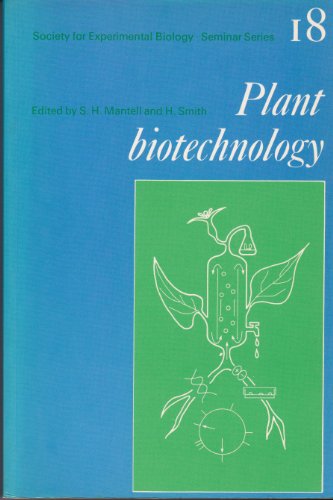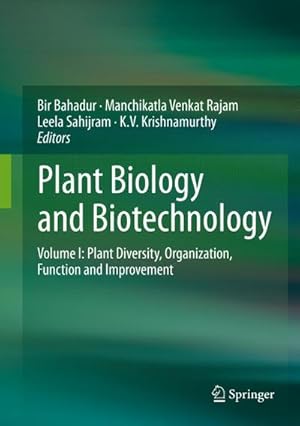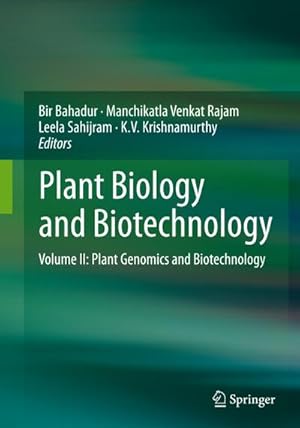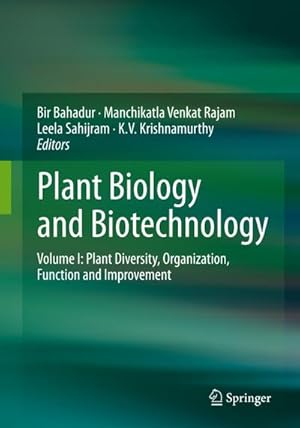plant biology biotechnology volume (7 Ergebnisse)
Produktart
- Alle Product Types
- Bücher (7)
- Magazine & Zeitschriften
- Comics
- Noten
- Kunst, Grafik & Poster
- Fotografien
- Karten
- Manuskripte & Papierantiquitäten
Zustand
Einband
Weitere Eigenschaften
- Erstausgabe (1)
- Signiert
- Schutzumschlag
- Angebotsfoto (5)
Gratisversand
- Versand nach USA gratis
Land des Verkäufers
Verkäuferbewertung
-
Plant Biotechnology: Volume 18, Plant Biotechnology (Society for Experimental Biology Seminar Series, Series Number 18)
Verlag: Cambridge University Press, 1985
ISBN 10: 0521287820ISBN 13: 9780521287821
Buch
Zustand: Good. Good condition. Volume 18. A copy that has been read but remains intact. May contain markings such as bookplates, stamps, limited notes and highlighting, or a few light stains.
-
Plant Biotechnology: Volume 18, Plant Biotechnology (Society for Experimental Biology Seminar Series, Series Number 18)
Verlag: Cambridge University Press, 1983
ISBN 10: 0521245508ISBN 13: 9780521245500
Anbieter: Cambridge Rare Books, Cambridge, GLOUC, Vereinigtes Königreich
Buch Erstausgabe
Hardcover. Zustand: GOOD. 1st Edition. 1983-09-08. Cambridge University Press. Hardcover. GOOD First Edition. DJ Good. Pages clean with clear text. Previous owners name. Fading to DJ. 10x7.
-
Plant Biology and Biotechnology. Volume II: Plant Genomics and Biotechnology.
Verlag: New Delhi, Springer., 2015
ISBN 10: 8132222822ISBN 13: 9788132222828
Anbieter: Antiquariat im Hufelandhaus GmbH vormals Lange & Springer, Berlin, Deutschland
Buch
768 p. Hardcover. Versand aus Deutschland / We dispatch from Germany via Air Mail. Einband bestoßen, daher Mängelexemplar gestempelt, sonst sehr guter Zustand. Imperfect copy due to slightly bumped cover, apart from this in very good condition. Stamped. Sprache: Englisch.
-
Plant Biology and Biotechnology, Volume 1 : Plant Diversity, Organization, Function and Improvement
Verlag: Springer Nature Singapore, 2015
ISBN 10: 8132222857ISBN 13: 9788132222859
Anbieter: AHA-BUCH GmbH, Einbeck, Deutschland
Buch
Buch. Zustand: Neu. Druck auf Anfrage Neuware - Printed after ordering - This volume offers a much-needed compilation of essential reviews on diverse aspects of plant biology, written by eminent botanists. These reviews effectively cover a wide range of aspects of plant biology that have contemporary relevance. At the same time they integrate classical morphology with molecular biology, physiology with pattern formation, growth with genomics, development with morphogenesis, and classical crop-improvement techniques with modern breeding methodologies. Classical botany has been transformed into cutting-edge plant biology, thus providing the theoretical basis for plant biotechnology.It goes without saying that biotechnology has emerged as a powerful discipline of Biology in the last three decades. Biotechnological tools, techniques and information, used in combination with appropriate planning and execution, have already contributed significantly to economic growth and development. It is estimated that in the next decade or two, products and processes made possible by biotechnology will account for over 60% of worldwide commerce and output. There is, therefore, a need to arrive at a general understanding and common approach to issues related to the nature, possession, conservation and use of biodiversity, as it provides the raw material for biotechnology. More than 90% of the total requirements for the biotechnology industry are contributed by plants and microbes, in terms of goods and services. There are however substantial plant and microbial resources that are waiting for biotechnological exploitation in the near future through effective bioprospection. In order to exploit plants and microbes for their useful products and processes, we need to first understand their basic structure, organization, growth and development, cellular process and overall biology. We also need to identify and develop strategies to improve the productivity of plants.In view of the above, in this two-volume book on plant biology and biotechnology, the first volume is devoted to various aspects of plant biology and crop improvement. It includes 33 chapters contributed by 50 researchers, each of which is an expert in his/her own field of research. The book begins with an introductory chapter that gives a lucid account on the past, present and future of plant biology, thereby providing a perfect historical foundation for the chapters that follow. Four chapters are devoted to details on the structural and developmental aspects of the structures of plants and their principal organs. These chapters provide the molecular biological basis for the regulation of morphogenesis of the form of plants and their organs, involving control at the cellular and tissue levels. Details on biodiversity, the basic raw material for biotechnology, are discussed in a separate chapter, in which emphasis is placed on the genetic, species and ecosystem diversities and their conservation.Since fungi and other microbes form an important component ofthe overall biodiversity, special attention is paid to the treatment of fungi and other microbes in this volume. Four chapters respectively deal with an overview of fungi, arbuscularmycorrhizae and their relation to the sustenance of plant wealth, diversity and practical applications of mushrooms, and lichens (associated with a photobiont). Microbial endosymbionts associated with plants and phosphate solubilizing microbes in the rhizosphere of plants are exhaustively treated in two separate chapters. The reproductive strategies of bryophytes and an overview on Cycads form the subject matter of another two chapters, thus fulfilling the need to deal with the non-flowering Embryophyte group of plants.Angiosperms, the most important group of plants from a biotechnological perspective, are examined exhaustively in this volume. The chapters on angiosperms provide an overview and cover the genetic basis of flowers development, pre-and post-fertilization reproductive growth and developme.
-
Plant Biology and Biotechnology : Volume II: Plant Genomics and Biotechnology
Verlag: Springer India, 2015
ISBN 10: 8132222822ISBN 13: 9788132222828
Anbieter: AHA-BUCH GmbH, Einbeck, Deutschland
Buch
Buch. Zustand: Neu. Druck auf Anfrage Neuware - Printed after ordering - Plant genomics and biotechnology have recently made enormous strides, and hold the potential to benefit agriculture, the environment and various other dimensions of the human endeavor. It is no exaggeration to claim that the twenty-first century belongs to biotechnology. Knowledge generation in this field is growing at a frenetic pace, and keeping abreast of the latest advances and calls on us to double our efforts. Volume II of this two-part series addresses cutting-edge aspects of plant genomics and biotechnology. It includes 37 chapters contributed by over 70 researchers, each of which is an expert in his/her own field of research.Biotechnology has helped to solve many conundrums of plant life that had long remained a mystery to mankind. This volume opens with an exhaustive chapter on the role played by thale cress, Arabidopsis thaliana, which is believed to be the Drosophila of the plant kingdom and an invaluable model plant for understanding basic conceptsin plant biology. This is followed by chapters on bioremediation, biofuels and biofertilizers through microalgal manipulation, making it a commercializable prospect; discerning finer details of biotic stress with plant-fungal interactions; and the dynamics of abiotic and biotic stresses, which also figure elsewhere in the book.Breeding crop plants for desirable traits has long been an endeavor of biotechnologists. The significance of molecular markers, marker assisted selection and techniques are covered in a dedicated chapter, as are comprehensive reviews on plant molecular biology, DNA fingerprinting techniques, genomic structure and functional genomics. A chapter dedicated to organellar genomes provides extensive information on this important aspect. Elsewhere in the book, the newly emerging area of epigenetics is presented as seen through the lens of biotechnology, showcasing the pivotal role of DNA methylation in effecting permanent and transient changes to the genome.Exclusive chapters deal with bioinformatics and systems biology. Handy tools for practical applications such as somatic embryogenesis and micropropagation are included to provide frontline information to entrepreneurs, as is a chapter on somaclonal variation.Overcoming barriers to sexual incompatibility has also long been a focus of biotechnology, and is addressed in chapters on wide hybridization and hybrid embryo rescue. Another area of accomplishing triploids through endosperm culture is included as a non-conventional breeding strategy. Secondary metabolite production through tissue cultures, which is of importance to industrial scientists, is also covered.Worldwide exchange of plant genetic material is currently an essential topic, as is conserving natural resources in situ. Chapters on in vitro conservation of extant, threatened and other valuable germplasms, gene banking and related issues are included, along with an extensive account of the biotechnology of spices - the low-volume, high-value crops. Metabolic engineering is another emerging field that provides commercial opportunities. As is well known, there is widespread concern over genetically modified crops among the public. GM crops are covered, as are genetic engineering strategies for combating biotic and abiotic stresses where no other solutions are in sight. RNAi- and micro RNA- based strategies for crop improvement have proved to offer novel alternatives to the existing non-conventional techniques, and detailed information on these aspects is also included. The book's last five chapters are devoted to presenting the various aspects of environmental, marine, desert and rural biotechnology. The state-of-the-art coverage on a wide range of plant genomics and biotechnology topics will be of great interest to post-graduate students and researchers, including the employees of seed and biotechnology companies, and to instructors in the fields of plant genetics, bree.
-
Plant Biology and Biotechnology : Volume II: Plant Genomics and Biotechnology
Verlag: Springer India, 2016
ISBN 10: 8132235355ISBN 13: 9788132235354
Anbieter: AHA-BUCH GmbH, Einbeck, Deutschland
Buch
Taschenbuch. Zustand: Neu. Druck auf Anfrage Neuware - Printed after ordering - Plant genomics and biotechnology have recently made enormous strides, and hold the potential to benefit agriculture, the environment and various other dimensions of the human endeavor. It is no exaggeration to claim that the twenty-first century belongs to biotechnology. Knowledge generation in this field is growing at a frenetic pace, and keeping abreast of the latest advances and calls on us to double our efforts. Volume II of this two-part series addresses cutting-edge aspects of plant genomics and biotechnology. It includes 37 chapters contributed by over 70 researchers, each of which is an expert in his/her own field of research.Biotechnology has helped to solve many conundrums of plant life that had long remained a mystery to mankind. This volume opens with an exhaustive chapter on the role played by thale cress, Arabidopsis thaliana, which is believed to be the Drosophila of the plant kingdom and an invaluable model plant for understanding basic conceptsin plant biology. This is followed by chapters on bioremediation, biofuels and biofertilizers through microalgal manipulation, making it a commercializable prospect; discerning finer details of biotic stress with plant-fungal interactions; and the dynamics of abiotic and biotic stresses, which also figure elsewhere in the book.Breeding crop plants for desirable traits has long been an endeavor of biotechnologists. The significance of molecular markers, marker assisted selection and techniques are covered in a dedicated chapter, as are comprehensive reviews on plant molecular biology, DNA fingerprinting techniques, genomic structure and functional genomics. A chapter dedicated to organellar genomes provides extensive information on this important aspect. Elsewhere in the book, the newly emerging area of epigenetics is presented as seen through the lens of biotechnology, showcasing the pivotal role of DNA methylation in effecting permanent and transient changes to the genome.Exclusive chapters deal with bioinformatics and systems biology. Handy tools for practical applications such as somatic embryogenesis and micropropagation are included to provide frontline information to entrepreneurs, as is a chapter on somaclonal variation.Overcoming barriers to sexual incompatibility has also long been a focus of biotechnology, and is addressed in chapters on wide hybridization and hybrid embryo rescue. Another area of accomplishing triploids through endosperm culture is included as a non-conventional breeding strategy. Secondary metabolite production through tissue cultures, which is of importance to industrial scientists, is also covered.Worldwide exchange of plant genetic material is currently an essential topic, as is conserving natural resources in situ. Chapters on in vitro conservation of extant, threatened and other valuable germplasms, gene banking and related issues are included, along with an extensive account of the biotechnology of spices - the low-volume, high-value crops. Metabolic engineering is another emerging field that provides commercial opportunities. As is well known, there is widespread concern over genetically modified crops among the public. GM crops are covered, as are genetic engineering strategies for combating biotic and abiotic stresses where no other solutions are in sight. RNAi- and micro RNA- based strategies for crop improvement have proved to offer novel alternatives to the existing non-conventional techniques, and detailed information on these aspects is also included. The book's last five chapters are devoted to presenting the various aspects of environmental, marine, desert and rural biotechnology. The state-of-the-art coverage on a wide range of plant genomics and biotechnology topics will be of great interest to post-graduate students and researchers, including the employees of seed and biotechnology companies, and to instructors in the fields of plant genetics, bree.
-
Plant Biology and Biotechnology : Volume I: Plant Diversity, Organization, Function and Improvement
Verlag: Springer India, 2016
ISBN 10: 8132229606ISBN 13: 9788132229605
Anbieter: AHA-BUCH GmbH, Einbeck, Deutschland
Buch
Taschenbuch. Zustand: Neu. Druck auf Anfrage Neuware - Printed after ordering - This volume offers a much-needed compilation of essential reviews on diverse aspects of plant biology, written by eminent botanists. These reviews effectively cover a wide range of aspects of plant biology that have contemporary relevance. At the same time they integrate classical morphology with molecular biology, physiology with pattern formation, growth with genomics, development with morphogenesis, and classical crop-improvement techniques with modern breeding methodologies. Classical botany has been transformed into cutting-edge plant biology, thus providing the theoretical basis for plant biotechnology.It goes without saying that biotechnology has emerged as a powerful discipline of Biology in the last three decades. Biotechnological tools, techniques and information, used in combination with appropriate planning and execution, have already contributed significantly to economic growth and development. It is estimated that in the next decade or two, products and processes made possible by biotechnology will account for over 60% of worldwide commerce and output. There is, therefore, a need to arrive at a general understanding and common approach to issues related to the nature, possession, conservation and use of biodiversity, as it provides the raw material for biotechnology. More than 90% of the total requirements for the biotechnology industry are contributed by plants and microbes, in terms of goods and services. There are however substantial plant and microbial resources that are waiting for biotechnological exploitation in the near future through effective bioprospection. In order to exploit plants and microbes for their useful products and processes, we need to first understand their basic structure, organization, growth and development, cellular process and overall biology. We also need to identify and develop strategies to improve the productivity of plants.In view of the above, in this two-volume book on plant biology and biotechnology, the first volume is devoted to various aspects of plant biology and crop improvement. It includes 33 chapters contributed by 50 researchers, each of which is an expert in his/her own field of research. The book begins with an introductory chapter that gives a lucid account on the past, present and future of plant biology, thereby providing a perfect historical foundation for the chapters that follow. Four chapters are devoted to details on the structural and developmental aspects of the structures of plants and their principal organs. These chapters provide the molecular biological basis for the regulation of morphogenesis of the form of plants and their organs, involving control at the cellular and tissue levels. Details on biodiversity, the basic raw material for biotechnology, are discussed in a separate chapter, in which emphasis is placed on the genetic, species and ecosystem diversities and their conservation.Since fungi and other microbes form an important component ofthe overall biodiversity, special attention is paid to the treatment of fungi and other microbes in this volume. Four chapters respectively deal with an overview of fungi, arbuscularmycorrhizae and their relation to the sustenance of plant wealth, diversity and practical applications of mushrooms, and lichens (associated with a photobiont). Microbial endosymbionts associated with plants and phosphate solubilizing microbes in the rhizosphere of plants are exhaustively treated in two separate chapters. The reproductive strategies of bryophytes and an overview on Cycads form the subject matter of another two chapters, thus fulfilling the need to deal with the non-flowering Embryophyte group of plants.Angiosperms, the most important group of plants from a biotechnological perspective, are examined exhaustively in this volume. The chapters on angiosperms provide an overview and cover the genetic basis of flowers development, pre-and post-fertilization reproductive growth and developme.








